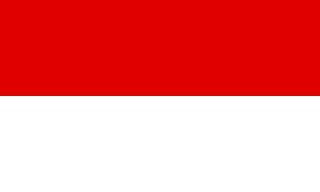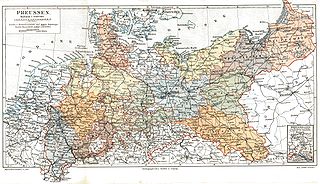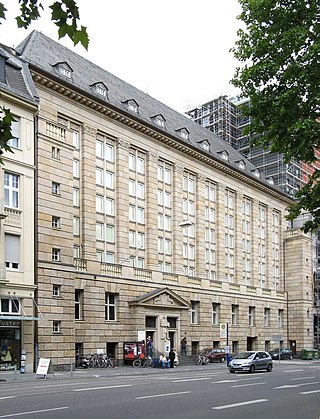
The Wiesbaden Region (German: Regierungsbezirk Wiesbaden) was one of three administrative regions (along with Darmstadt Region and Kassel Region) from which the state of Hesse was formed in 1945.

The Wiesbaden Region (German: Regierungsbezirk Wiesbaden) was one of three administrative regions (along with Darmstadt Region and Kassel Region) from which the state of Hesse was formed in 1945.
Following the Prussian annexations after the Austro-Prussian War of 1866, the administrative region of Wiesbaden was founded on February 22, 1867, comprising the formerly independent Duchy of Nassau, the Landgraviate of Hesse-Homburg and the formerly Free City of Frankfurt, previously states of the German Confederation. The Wiesbaden Region was one of the two political subdivisions (along with Kassel Region) within the province of Hesse-Nassau (the Prussian province formed in 1868 including, besides the Wiesbaden Region, further the former Electorate of Hesse, previously another member of the German Confederation).
In 1945 the northwestern part of region was dissected, when the Wiesbaden Region was divided between the American and the French zone of occupation in Germany. The bulk of region with the city of Wiesbaden continued to exist as a region within the new state of Hesse. The dissected northwest formed a new region, the Montabaur Region within Rhineland-Palatinate.
In 1968, the region was dissolved, and its territory was merged in the Darmstadt Region.
Unlike other Prussian regions the Wiesbaden Region was not only an administrative entity of the Prussian government, but its pertaining counties formed a body, the Bezirksverband Nassau or Wiesbaden (about: regional association), [1] with its own representative assembly (Nassauischer Kommunallandtag Wiesbaden, i.e. Nassau Communal Diet, existed between 1866 and 1933) and premises provided and tasks fulfilled for the entirety of the counties within the region. These tasks comprised among others schools, traffic installations, sanitary premises, hospitals, cultural institutions, jails etc. The same was the case in the Kassel Region with an own assembly (Kurhessischer Kommunallanddtag Kassel).
In most other Prussian provinces the tasks and rights of a Bezirksverband were fulfilled by the Provinzialverband (provincial association), comprising as members all the counties in a province instead of a region. The Nassau Communal Diet elected a regional government (first Verwaltungsausschuss, later Landesausschuss, i.e. administrative / land committee) presided over by the Landesdirektor (i.e. land director) or Landeshauptmann (i.e. land captain). [1] On 8 June 1885 the Kommunalständischer Verband Frankfurt (i.e. Communal Estate Association of Frankfurt), holding the same responsibilities in the territory of the former Free City of Frankfurt upon Main, was merged into the regional association of Wiesbaden. [1] The same reform enfranchised the Nassau Communal Diet to elect representatives for the newly established provincial diet of the Province of Hesse-Nassau, first convened in 1886. [1]
In the course of the democratisation of the Prussian administration after 1918 the communal diets were directly elected by the people. After the abolition of the Nassau Communal Diet by the Nazi dictatorship each Landeshauptmann was appointed. After 1945 the administrative committees elected the Landeshauptmann, the regional parliament was not reestablished. In 1953 the Wiesbaden regional association was dissolved and its tasks and assets transferred to the new statewide State Welfare Association of Hesse (Landeswohlfahrtsverband Hessen).
| Parties | % 1921 | +/- 1921 | Seats 1921 | +/- 1921 | % 1925 | +/- 1925 | Seats 1925 | +/- 1925 | % 1929 | +/- 1929 | Seats 1929 | +/- 1929 | % 1933 | +/- 1933 | Seats 1933 | +/- 1933 | |
|---|---|---|---|---|---|---|---|---|---|---|---|---|---|---|---|---|---|
| SPD | 29.9 | 18 | 30.6 | +0.7 (-4.6) | 16 | -2 (-5) | 26.2 | -4.4 | 14 | -2 | 17.8 | -8.4 | 10 | -4 | |||
| USPD | 5.3 | +5.3 | 3 | +3 | merged in SPD | ||||||||||||
| Zentrum | 20.6 | 12 | 22.5 | +1.9 | 12 | -2 | 18.9 | -3.6 | 10 | -2 | 16.1 | -2.8 | 10 | 0 | |||
| DVP | 18.2 | +18.2 | 11 | +11 | 6.3 | -5.9 | 3 | -8 | 9.7 | +3.4 | 5 | +2 | 0 | -5 | |||
| DNVP [2] | 10.8 | +10.8 | 7 | +7 | 5.4 | -5.4 | 3 | -4 | 5.2 | -0.2 | 3 | 0 | 6 [2] | +0.8 | 4 | +1 | |
| DDP [3] | 9.7 | +9.7 | 7 | +7 | 5.9 | -3.8 | 4 | -3 | 4.5 | -1.4 | 3 | 0 | 1.7 [3] | -2.8 | 0 | -3 | |
| KPD [4] | 3.4 | +3.4 | 2 | +2 | 6.4 | +3 | 4 | +2 | 8.21 | +1.81 | 5 | +1 | 7 | -1.21 | 4 | -1 | |
| HNASL | not run | not run | not run | not run | 14.1 | +14.1 | 7 | +7 | 0 | -7 | 0 | 0 | |||||
| WP | not run | not run | not run | not run | 7.8 | +7.8 | 3 | +3 | 5.1 | -2.7 | 3 | 0 | 0 | -3 | |||
| NSDAP | not run | not run | not run | not run | 8.19 | 4 | +4 | 48.6 | +40,41 | 27 | +23 | ||||||
| CNBL | not run | not run | not run | not run | not run | not run | not run | not run | 8.4 | +8.4 | 5 | +5 | 0 | -5 | |||
| NaLa | 1 | +1 | 0 | -1 | 0 | 0 | 0 | 0 | |||||||||
| Total 1921 | 61 | Total 1925 | 52 | Total 1929 | 52 | Total 1933 | 55 | ||||||||||

Hesse or Hessia, officially the State of Hesse, is a state in Germany. Its capital city is Wiesbaden, and the largest urban area is Frankfurt, which is also the country's principal financial centre. Two other major historic cities are Darmstadt and Kassel. With an area of 21,114.73 square kilometers and a population of over six million, it ranks seventh and fifth, respectively, among the sixteen German states. Frankfurt Rhine-Main, Germany's second-largest metropolitan area, is mainly located in Hesse.

Wiesbaden is the capital of the German state of Hesse, and the second-largest Hessian city after Frankfurt am Main. With around 283,000 inhabitants, it is Germany's 24th-largest city. Wiesbaden forms a conurbation with a population of around 500,000 with the neighbouring city of Mainz. This conurbation is in turn embedded in the Rhine-Main Metropolitan Region—Germany's second-largest metropolitan region after Rhine-Ruhr—which also includes the nearby cities of Frankfurt am Main, Darmstadt, Offenbach am Main, and Hanau, and has a combined population exceeding 5.8 million.

The Province of Hesse-Nassau was a province of the Kingdom of Prussia from 1868 to 1918, then a province of the Free State of Prussia until 1944.

The Frontier March of Posen–West Prussia was a province of Prussia from 1920/1922 to 1938, covering most of lands of historical Greater Poland that were not included in the Second Polish Republic. Posen–West Prussia was established in 1922 as a province of the Free State of Prussia within Weimar Germany, formed from merging three remaining non-contiguous territories of Posen and West Prussia, which had lost the majority of their territory to the Second Polish Republic following the Greater Poland Uprising. From 1934, Posen–West Prussia was de facto ruled by Brandenburg until it was dissolved by Nazi Germany, effective 1 October 1938 and its territory divided between the provinces of Pomerania, Brandenburg and Silesia. Schneidemühl was the provincial capital. Today, lands of the province are entirely contained within Poland.

The Provinces of Prussia were the main administrative divisions of Prussia from 1815 to 1946. Prussia's province system was introduced in the Stein-Hardenberg Reforms in 1815, and were mostly organized from duchies and historical regions. Provinces were divided into several Regierungsbezirke, sub-divided into Kreise (districts), and then into Gemeinden (townships) at the lowest level. Provinces constituted the highest level of administration in the Kingdom of Prussia and Free State of Prussia until 1933, when Nazi Germany established de facto direct rule over provincial politics, and were formally abolished in 1946 following World War II. The Prussian provinces became the basis for many federal states of Germany, and the states of Brandenburg, Lower Saxony, and Schleswig-Holstein are direct successors of provinces.

Jakob Sprenger was a Nazi Party official and politician who was the Party's Gauleiter of Hesse-Nassau South from 1927 to 1933 and Gau Hesse-Nassau from 1933 to 1945. He was also the Reichsstatthalter and Minister-President of the People's State of Hesse, the Oberpräsident of the Prussian Province of Nassau and an SA-Obergruppenführer.

The Province of Hanover was a province of the Kingdom of Prussia and the Free State of Prussia from 1866 to 1946.

The Province of Brandenburg was a province of Prussia from 1815 to 1947. Brandenburg was established in 1815 from the Kingdom of Prussia's core territory, comprised the bulk of the historic Margraviate of Brandenburg and the Lower Lusatia region, and became part of the German Empire in 1871. From 1918, Brandenburg was a province of the Free State of Prussia until Prussia was dissolved in 1945 after World War II, and replaced with reduced territory as the State of Brandenburg in East Germany, which was later dissolved in 1952. Following the reunification of Germany in 1990, Brandenburg was re-established as a federal state of Germany, becoming one of the new states.

The Duchy of Nassau was an independent state between 1806 and 1866, located in what is now the German states of Rhineland-Palatinate and Hesse. It was a member of the Confederation of the Rhine and later of the German Confederation. Its ruling dynasty, now extinct, was the House of Nassau. The duchy was named for its historical core city, Nassau, although Wiesbaden rather than Nassau was its capital. In 1865, the Duchy of Nassau had 465,636 inhabitants. After being occupied and annexed into the Kingdom of Prussia in 1866 following the Austro-Prussian War, it was incorporated into the Province of Hesse-Nassau. The area today is a geographical and historical region, Nassau, and Nassau is also the name of the Nassau Nature Park within the borders of the former duchy.

The People's State of Hesse was one of the constituent states of Germany from 1918 to 1945, as the successor to the Grand Duchy of Hesse after the defeat of the German Empire in World War I, on the territory of the current German states of Hesse and the Rhineland-Palatinate. The State was established after Grand Duke Ernest Louis was deposed on 9 November 1918. The term "People's State" referred to the fact that the new state was a Republic and was used in the same manner as the term Free State, which was employed by most of the other German States in this period.

The Museum Wiesbaden is a two-branch museum of art and natural history in the Hessian capital of Wiesbaden, Germany. It is one of the three Hessian State museums, in addition to the museums in Kassel and Darmstadt.

Greater Hesse was the provisional name given for a section of German territory created by the United States military administration in at the end of World War II. It was formed by the Allied Control Council on 19 September 1945 and became the modern German state of Hesse on 1 December 1946.

The Province of Nassau was a province of Prussia from 1944 to 1945.
The politics of Hesse takes place within a framework of a federal parliamentary representative democratic republic, where the Federal Government of Germany exercises sovereign rights with certain powers reserved to the states of Germany including Hesse. The state has a multi-party system where, as in most other states of former Western Germany and the federal level, the three main parties are the centre-right Christian Democratic Union (CDU), the far-right Alternative for Germany (AfD), and the centre-left Social Democratic Party of Germany (SPD).

RheinMain University and State Library, formerly Nassau State Library and Hessian State Library, is funded by the State of Hesse and located in Wiesbaden and Rüsselsheim. With collections currently comprising over one million items, it is one of Germany's medium-sized libraries. The major special collection is on the former state of Nassau, in which the library has its roots. As of 1 January 2011 it became part of RheinMain University of Applied Sciences. It is a central service facility of the RheinMain University of Applied Sciences and provides literature for the population of the city and region.
Karl Linder was a Nazi Party (NSDAP) official who served as Gauleiter of Gau Hesse-Nassau South and Gau Hesse-Nassau as well as in many governmental positions, including as Second Bürgermeister of Frankfurt am Main. A member of the Sturmabteilung (SA), Linder held the rank of SA-Brigadeführer.
Peter Gemeinder was a Gauleiter of the Nazi Party (NSDAP) and a member of the German Reichstag.

The Hessian Central State Archives, Wiesbaden is a department of the Hessian State Archives and is located in Wiesbaden, the capital of the German state of Hesse. It serves alongside the Hessian State Archives, Darmstadt and the Hessian State Archives, Marburg as the main regional archives for Hesse and additionally functions as the central archives for the state government and ministries, as well as other institutions with nationwide jurisdiction.
These are lists of political office-holders in Brandenburg.